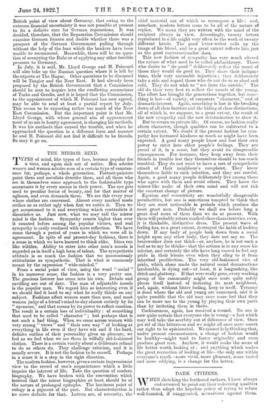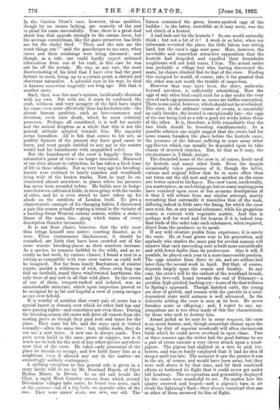DARK CITIZENS.
WHEN sketching the feathered outlaws, I have always endeavoured to point out their redeeming qualities rather than adopt the hopeless policy of trying to refute well-founded, if exaggerated, accusations against them. In the Carrion Crow's case, however, those qualities, though by no means lacking, are scarcely of the sort to plead his cause successfully. True, there is a great deal about him that appeals strongly to the nature lover, but the average countryman, like the game-preserver, has little use for the dusky thief. " Them and the rats are the worst things out ! said the gamekeeper to me once, when crows and their misdoings were being discussed ; and though, as a rule, one could hardly expect unbiased information from one of his craft, in this case he was not far off the metals. He was, at any rate, the most discriminating of his kind that I have ever had the good fortune to meet, being, up to a certain point, a shrewd and observant naturalist. A splendid man in his way, he died in harness somewhat tragically not long ago. But that is another story. Such, then, was this man's opinion, incidentally identical with my own. But with me, it must be confessed, the craft, wildness, and very savagery of the bird have urged his cause even more effectively than has his better side—the almost human qualities, such as love-constancy and devotion, even unto death, which he most certainly possesses. Perhaps, all considered, it is well for society and the animal kingdom as a whole that this is not the general attitude adopted towards him. His rapacity seems boundless. All is fish that comes to his net, as poultry farmers of the present day have good cause to know, and most people entitled to any say in the matter would hail his banishment with unqualified relief.
But the banishment of the crow is happily—from the naturalist's point of view—no longer imminent. Harassed at one time almost to extinction, he has taken a fresh lease of life in these islands. Not so very long ago his breeding- haunts were confined to lonely marshes and woodlands lying wide of the beaten tracks. Now, he may be en- countered almost anywhere, in places where his presence has never been recorded before. He builds now in hedge- rows between cultivated fields, in trees grimy with the smoke of cities, and he is even stated to have taken up his abode on the outskirts of London itself. To give a characteristic example of his changing habits, I discovered a pair this season actually rearing a brood in the vicinity of a bustling Great Western railway station, within a stone's throw of the main line, along which trains of every description thunder incessantly.
It is not from choice, however, that the wily crow thus brings himself into notice, courting disaster, as it were. These venturesome blackamoors, it should be remarked, are birds that have been crowded out of the more remote breeding-places as their numbers increase. As a species, he remains faithful to the wilds, and as re- cently as last week, by curious chance, I found a nest in a setting as compatible with true crow nature as could well be imagined. Not far from lonely Raybarrow, of sinister repute, amidst a wilderness of rock, where even ling can find no foothold, stand three wind-twisted hawthorns, the only trees of any sort in all that wild place. In the crown of one of these, tempest-rocked and isolated, was an unmistakable structure, which upon inspection proved to be occupied by as fat and hopeful a crew of young savages as eye ever beheld.
It is worthy of mention that every pair of crows has a special haunt or domain over which no other bird has any save passing rights—and sometimes not even those. During the breeding season old crows will drive all corners from the nesting grove as though they paid rent and taxes for the place. They mate for life, and the same spot is visited annually—often the same tree : but, unlike rooks, they do not use a nest twice. A new one is always made. Two pairs never build in the same grove or coppice, nor is it much use to look for the nest of any other species anywhere near that of the crow. He takes early possession of the place he intends to occupy, and few birds fancy him as a neighbour, even if allowed any say in the matter—an exceedingly unlikely contingency. A striking exception to this general rule is given in a story lately told to me by Mr. Rowland Huysh, of Clyst Hydon Manor, in Devon. In an old oak beside the Clyst, a rapid West Country stream from which several Devonshire villages take name, he found two nests, each at the extreme end of a big limb, on opposite sides of the tree. They were crows' nests, one new, one old. The former contained the green, brown-spotted eggs of the builder ; in the latter, incredible as it may seem, was the red clutch of a kestrel.
A bad look-out for the kestrels ? So one would naturally think ; but not a bit of it ! A week Or so later, when my informant revisited the place, the little falcon was sitting hard, but the crow's eggs were gone. Here, however, the inevitable and somewhat attractive supposition that the kestrels had despoiled and expelled their formidable neighbours will not hold water, I fear. The actual raider was probably a village boy who, having discovered the nests, by chance climbed first to that of the crow. Finding this occupied he would, of course, take it for granted that the other was not worth the trouble of inspection. However that may have been, the story, authentic beyond question, is sufficiently astonishing. How the eggs of any other bird could exist for a day under the very eyes of such egg-gourmands as crows are baffles conception. There is one point, however, which should not be overlooked. The crow, in the ordinary course of events, is essentially an early breeder, the kestrel is exceptionally late—the eggs of the one being laid as a rule a good six weeks before those of the other. It is, therefore, a little remarkable that the two birds should be brooding simultaneously. As a possible solution one might suggest that the crows had for some reason forsaken the place before the kestrels came, the presence of the falcons sufficing to scare away other egg-thieves which can usually be depended upon to take charge of deserted clutches. But, be that as it may, the circumstance is, I-think, unique. The discarded home of the crow is, of course, freely used by kestrels and many other birds. Even the magpie occasionally takes possession of it, though the latter, curious and original fellow that he is, more often than not turns out the old nest and erects another on the same site better suited to his fancy. The crow's nest, incidentally, is a masterpiece, as such things go, but so many aspiring pens have ventured upon more or less accurate descriptions of it that I will refrain from any similar attempt, merely remarking that outwardly it resembles that of the rook, differing indeed in little save the lining, for which the crow uses wool, fur, or any animal substance, while his gregarious cousin is content with vegetable matter. And this is perhaps well for wool and fur bearers if it is indeed true that birds of this order take such substances, when required, direct from the producer, so to speak.
If any wild creature profits from experience, it is surely the crow. He at least grows wise in his generation, and anybody who studies the same pair for several seasons will observe that each succeeding nest is built more scientifically and with fewer faults than its predecessor. Also it will, if possible, be placed each year in a more inaccessible position. The eggs number from three to six, and are seldom laid later than the second week in April. But that, of course, depends largely upon the season and locality. In any case, the crow's will be the earliest of the woodland broods, and his love-call, heard towards the end of February—a peculiar, high-pitched, barking cry—is one of the first tributes to Spring's approach. Though hatched early, the young are slow of growth, and remain with the parents in a semi- dependent state until autumn is well advanced. In the domestic setting the crow is seen at its best. He never forsakes mate or offspring ; and, I regret to say, un- scrupulous use is too often made of this fine characteristic by those who seek to destroy him.
Arrant jackal as he may be in some respects, the crow is no mean hunter, and, though somewhat clumsy upon the wing, by dint of superior woodcraft will often circumvent birds which he could never overhaul in open chase. TWD or three seasons ago the writer had the good fortune to see a pair of crows execute a very clever attack upon a wood- pigeon. The pigeon had alighted in a tree to pick ivy- berries, and was so busily employed that it had no idea of danger until too late. The moment it saw the pirates it was in the air, of course, and would have been away, but they were well above it by that time, and by their combined efforts so bothered its flight that it could never get under full headway. The co-operation and generalship displayed by the crows were wonderful to see. No matter how the quarry swerved and looped—and a pigeon's turn in air rivals the lightning's" flash—they always contrived that one or other of them menaced its line of flight. At last the pigeon fell, but, curiously enough, the crows upon this occasion reaped no benefit from their achieve- ment. The stricken bird dropped into a hawthorn tangle, around which the victors quested vainly until I inter- rupted the search to satisfy my own curiosity. The pigeon's neck had been practically severed, I found, as by a bullet, and one blow must have done the mischief. This was an exceptional performance, no doubt. None the less, I am inclined to think that, by dint of nest-robbing, the crow exacts an even heavier toll of woodpigeon life than does the rapacious sparrowhawk. He is beyond a doubt the most formidable factor in the British woods to-day, and most dreaded by one and all. He will attack the heron fearlessly—jointly, that is, with his mate. Nor is the buzzard's eyrie immune from his raids. It should be noted that the peewit, so clamorously aggressive towards almost any other intruder, more often than not maintains a significant silence when a crow's shadow falls across her fallow. Indeed, so far as my own observation serves, the only bird who effectually puts him to the rightabout is the curlew. She, at any rate, does so with scant ceremony, nor does he put up any semblance of a fight against her. His diet is absolutely omnivorous. A liver upon flesh for choice, he will demolish grain, meal, or green herbs with avidity. Eggs of all sorts and descriptions, from the wood- wren's clutch to those of the domestic turkey, are his great weakness, however, and these he will collect and " cache," pie-like, in some dark corner of the woods.
As a study he can never fail to be interesting. He is a representative feature of the wild to which he belongs, and, despite his undeniable villainies, I cannot help being unreservedly glad that he is holding his own so successfully in the struggle for existence. DOUGLAS GORDON.




































 Previous page
Previous page